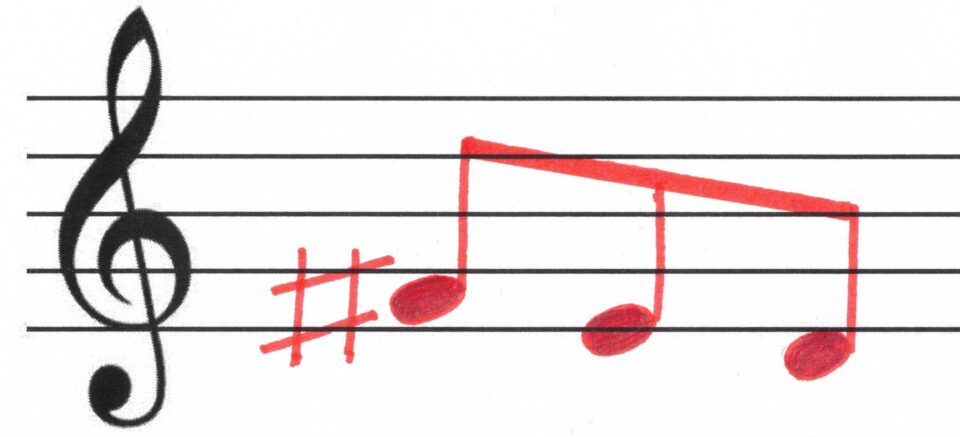Vocal riffs and runs have been one of the great moments in rock and pop music for as long as it has existed: When the band stops at the end of a song and the singer gets everything out of her last note. With a breathtakingly fast ascending or descending melody line. It is just a syllable of a word or a vowel that is skilfully stretched over many notes.
This is called a "melisma", or more contemporary: a "vocal run". Or a "riff", if the fast sequence of notes is rhythmically embedded in the song and recurs regularly. If you want to learn to sing riffs yourself, I'll give you a few simple exercises in this blog article to help you get started.
What is a vocal riff?
A vocal riff or run is a demonstration of vocal agility and acrobatics. Here you can see a few outstanding examples of this, wildly cut together:
Do you have to be able to do that? Fortunately, no, at least not if you don't want to become a vocal acrobat. But it does add an important tool to your toolbox as a singer if you know a few melodic ornaments or scales.
A simple melody gains enormously from a little embellishment, as you hear in the very beginning of Ed Sheeran's next song. It's just little swings of notes, on the words "le-egs", "ca-an't" or "mo-outh" that make the difference. Quick sequences of notes, up and then (in the chorus) down, that add elegance to the sung melody.
How do you sing such fast tone sequences on a syllable or a vowel? Many beginners find this more difficult than expected. When you first tried to sing a riff or a run from your favourite star, you may have stumbled: the notes came too slowly, sounded crooked in between or blurred together. There are a number of effective vocal exercises to learn how to sing a vocal riff.
The key: vibrato
In the edited video at the beginning, you may have noticed that the stars often end their vocal runs with vibrato. At the same speed as they sang their run before. This is no coincidence.
The key to all these virtuoso rises and falls is the vibrato: the rhythmic rise and fall of the sound sung out. It is the same rhythm, the same pulsation with which the stars also rise and fall in their riffs and runs.
You don't want to sing with vibrato because it sounds too oldschool? Don't worry, you don't have to in the end. Think of it as a tool for your box: your ability to make a note pulse rhythmically quickly helps you sing fast riffs and runs.
Pretend to laugh, but not loudly, openly ("Ha - Ha - Ha"), but restrained. With your mouth closed, in a quick sequence of sounds: "hm - hm - hm - hm - hm". Put your hand on your belly and do it again: do you feel the slight bouncing up and down of your belly area? That is your large breathing muscle, the diaphragm, pulsating, together with your abdominal muscles.
From breath wave to vocal run: a proven exercise
Your "hm - hm - hm ..." is a so-called "staccato", a rhythmic sequence of separate notes. The rhythmic pulsation that your diaphragm gets into helps you to sing your riffs and runs. Vocal runs are like a fast staccato, connected to a continuous melody line, a "legato". The following exercise will take you there:
- Sing the quick "hm - hm - hm - hm - hm" again, as if in a restrained laugh, but on one and the same note. Feel the bouncing up and down of your abdomen coming from the diaphragm. At the end, descend in five steps (a fifth), staying in staccato:

- Then open your mouth and do the same staccato exercise again with the vowel "A", with the descent in five tone steps at the end. Make sure to take out the breath at the beginning of each tone, the "hA" if possible, towards one: "A - A - A - A". And, importantly: even if the "h" is omitted, sing the staccatos with a soft swelling of the single notes (not with a hard, "glottal" Sound attachment).
- Finally, sing the sequence of notes with the vowel "A" again, in the same rhythm, but this time with connected notes, in legato. Your sounds now sound like rhythmic accents on each individual "A". Continue to feel the small pulsation of your abdomen with each accent. Your larynx and jaw remain relaxed from beginning to end.
With the connected, accentuated tones, you have now moved into a vibrato: You are singing on the "breath wave" that we described in the blog article about the Vibrato under the microscope. And the downward tone sequence has become a "vocal run".
Practise tone sequences and scales
What's next? Descending vocal runs or riffs are the easiest to sing, and they are also the most common. In Ed Sheeran's song, you hear a fast descending third in the chorus over and over again. It is often used to embellish a melody:

In pop and soul singing you have probably heard the descending blues scale (without the b sign it is also called "pentatonic scale"):

Slightly more difficult are ascending or ascending and descending runs. Our tip: If you get out of rhythm or the notes become blurred, start again with staccato notes, which you then smooth out into a pulsating legato line:

Then pick a run or a recurring riff from one of your song favourites. When practising, it's best to start in the middle range and sing slowly at first. Only when you are sure you are hitting each note correctly, sing the notes faster. Pick a vowel that you feel comfortable with.
Maybe you hum the sequence or scale first, or you start with a small "U". Do you like to sing soulfully and "beltest"If you like it, use an open "O" (as in "Wonne") or "A". Only when you feel confident with this, practice with the syllable on which the riff or run is sung in your song.
Vocal technical requirements
Vocal runs sound particularly impressive when the stars sing them in high register or over a wide range. If you practise the blues scale not only in the speaking voice range, but go up with it step by step, you will soon reach a limit where you have to "switch" vocally: from the full-sounding "chest voice" to the "head voice" and back.
The "platform" for switching is your middle voice: it lies between Chest and head voice and allows you to switch back and forth between the two vocal registers without your listeners hearing a break. Therefore, do regularly Exercises for the Alternating between chest and head voice from the middle voice. Then you can sing runs in higher registers, up and down, as far as your vocal range goes.
And you need a good Breathing and support technique for your vocal runs. Before each run, inhale with a short diaphragmatic pulse (belly breath). Just enough for your vocal phrase, without a feeling of air congestion in your lungs. As you sing your phrase, maintain the inhalation posture. Keep your intercostal muscles active to keep your chest expanded as long as possible while singing.
Vocal riffs and runs sound great and inspire the audience. They are also good practice for your vocal agility and speed. They are fun, but also demanding from a vocal point of view. It's best to have an experienced vocal coach help you practise.
You can also find good exercises for register changes or breathing techniques in my online singing courses. Feel free to check out my course offerings:
https://singasong-behappy.de/online-gesangsunterricht/






